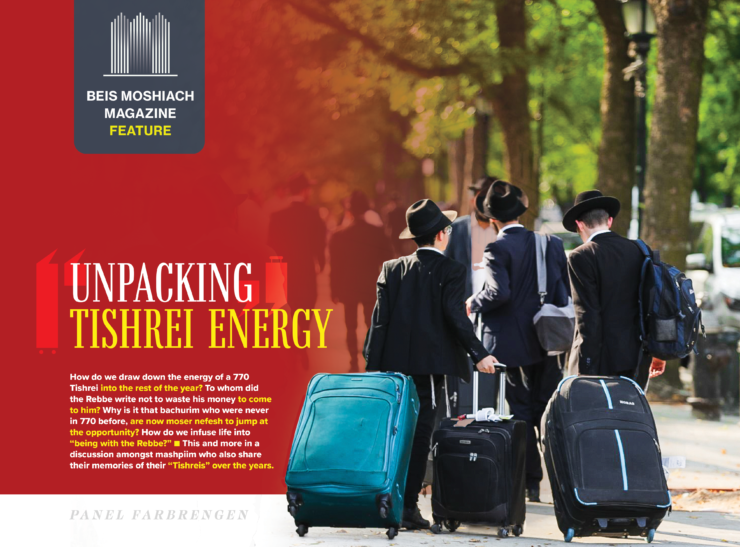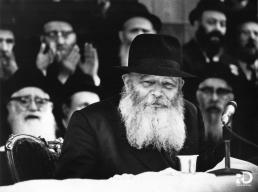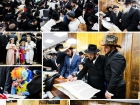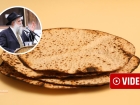Why Did the Rebbe Sell 770?
Precisely fifty years ago on the last night of Pesach 5729 the Rebbe called for action. A call to arms to save the Crown Heights Jewish community from destruction. As explained in the previous issue, neighborhoods in Brooklyn with a majority population of ultra-Orthodox Jews began to fill with immigrants. Dov Levy uncovers more details of the Rebbe’s deep involvement in saving the Crown Heights Jewish community from devastation • Full Article
Precisely fifty years ago on the last night of Pesach 5729 the Rebbe called for action. A call to arms to save the Crown Heights Jewish community from destruction.
As explained in the previous issue, neighborhoods in Brooklyn with a majority population of ultra-Orthodox Jews began to fill with immigrants. Without proper jobs, many turned to petty crime to make an easy dollar.
What was once the American center of traditional Orthodoxy deteriorated almost beyond repair. The hallowed stones of the renowned Kingston Avenue and Eastern Parkway, once resounding with the hurried footfalls of pious Jews running to buy kosher meat or reserving a spot at their Rebbe’s tish now cowered in fear under the heavy tread of the criminals that roamed them. The storefronts that shouted their Jewishness, holding treasures of sefarim and Judaica were now boarded up and abandoned. The jewelers, barbershops, and grocers who once so proudly catered to their Orthodox constituency, now quivered fearfully, hoping that obscurity would spare them being robbed and plundered.
Shuls were left vacant, Jewish schools were emptied, and many kosher businesses were closed. Even those who remained, sold their properties and leased them out, trying to squeeze as much profit as possible before the plunging market made their property worthless.
Other communities were wholly abandoned, leaving only the elderly who did not have the strength to move. Some of these neighborhoods still remain “ghost towns” of Jewish life, with only a few struggling families to make up the minyan, or worse, the beautiful shuls sold to churches, the empty Aron Kodesh forced to watch the pagan rituals happening before its eyes.
The Rescue Team
The possibility of this happening to Crown Heights caused the Rebbe much aggravation. The community and neighborhood held a very dear place in the Rebbe’s heart, firmly maintaining that kedusha loh zazah mimekomah — the holiness the Previous Rebbe imbued in 770 and in the neighborhood is immovable. And unlike others who fled without a backwards glance, the Rebbe was not willing to give up on it.
If not for the Rebbe’s intense battle, Crown Heights would have followed the same path as those other lost neighborhoods. It happened in Harlem and it could have happened in Crown Heights.
Today, one can walk around more-or-less safely even in the late hours of the night after a Shabbos meal or at the end of a family simcha. In those years, the dark years of Crown Heights, it was unheard of. Walking on Kingston Avenue after nightfall was something nobody would do alone. Those who did suffered for it, often getting hurt, robbed and at times even worse…
Rabbi Chodakov, the Rebbe’s chief secretary, shared a memory that once while driving with the Rebbe home from a wedding, the Rebbe noticed a group of couples walking home, an unusual sight in those fear-filled days. The Rebbe enjoyed the sight and even commented, “Look. How beautiful! People are walking freely with no fear.”
As much as the Rebbe begged and pleaded, it took some years until people actually began to take action.
Jewish Protection Force
To solve the problem of the rising crime, the first priority was to form a Jewish agency with a patrol system designed to protect the locals at night from break ins, robberies, and muggings. The group, established by Reb Shmuel Shraga, coined themselves “the Maccabees,” although they later become known as “Shmira.”
Aside from circling the streets after dark, they would offer rides to and from shul or even to the supermarket. The Maccabees gave the community a feeling of safety and security.
The self-directed patrol group caused a loud furor in the local media. Many reported a negative spin on the story, citing that vigilante justice was a distortion of the law. The spotlight on Crown Heights in the news caused real estate interest to drop even lower. Community members, watching their investments lose value by the minute, begged the Maccabee coordinator, Shmuel Shraga, to intercede and call off his patrols. They hoped the concession would make the media lose interest and Crown Heights could try to shed its notoriety.
However, when Shraga asked the Rebbe, the Rebbe told him that not only should he not cease his activities, he should increase patrols and try to do even more to secure the neighborhood.
Shmuel Shraga’s influence and impact was felt even after he passed on. He suffered a sudden heart attack while he was relatively young, and an ambulance was immediately called. The African American EMT refused to help, saying that he would not dirty his uniform for a filthy Jew. The horrified bystanders convinced him to do his job, but he did so with unnecessary force and brutality. Eyewitnesses later shook their heads and said, “He murdered him.”
Shraga’s widow was determined that no other Jew should have to suffer the whims of anti-Semitic paramedics. She raised the funds for Crown Heights’ first Hatzalah ambulance. The Rebbe donated $120 dollars towards the truck himself.
Crown Heights Pride
Once the safety and well-being of the community was addressed, the Rebbe turned to rebuilding and rebranding it, asking for events to be held within Crown Heights.
In a sicha of Parsha Vayeishev 5730, the Rebbe thanked a local organization that chose to hold their fundraising dinner in Crown Heights. The Rebbe added a request that others do the same in order to strengthen the community.
But it wasn’t only public events on which the Rebbe had an eye. The Rebbe encouraged chassidim multiple times to hold their personal simchas in local halls.
When Rabbi Michoel Teitelbaum purchased the Oholei Torah building from a Conservative Jewish Center, he included a wedding hall as per the Rebbe’s request.
Because of its spotty history, some refused to enter. The Jacobson family rented the hall for a wedding, but the grandfather of the kalla, Rabbi Yaakov Lipsker said that he refused to attend if it would be held there. The father of the chosson, Reb Gershon Ber Jacobson, was flummoxed and decided to make the wedding outside of Crown Heights instead. The Rebbe told him not to switch locations and asked him to find another solution. The wedding was finally held in a tent in the yard of the Beis Rivka building. The Rebbe was pleased that the wedding did not move outside of Crown Heights.
The Rebbe encouraged all other types of community events to be held in Crown Heights as well. The dinner for descendants of the Alter Rebbe, the N’shei Chabad convention, the banquet of the Kinnus Hashluchim, and Tzivos Hashem rallies were all held in Crown Heights following the Rebbe’s instruction.
One specific N’shei Chabad event was geared for women of other communities. The Rebbe requested that regardless, the event should be held in Crown Heights, despite their plans to rent a hall in a more convenient location like Flatbush or Boro Park. In the end, the event was packed, with half of the participants commuting from other neighborhoods.
Through various events, simchas, and occasions being held in Crown Heights, others were attracted to the community, thereby strengthening its support and members.
Local Businesses
With the streets becoming safer and public events being held without fear, the Rebbe addressed the economical situation of the local businesses, encouraging Crown Heightsers to patronize local shops, Jewish owned or not. Quoting the halacha that the poor of one’s own community is paramount, the Rebbe asked chassidim to shop locally and support their resident business owners.
The Rebbe cared not only for the Chassidim of the community but for the non-Jews as well. In the year 5737 (1977), there was a blackout that affected a large area of Crown Heights. The Rebbe had the secretaries find out how much damage all the businesses suffered, including the non-Jewish stores, and offered to pay for it. In the end, the government ended up paying for it all.
The Shuls
With the physical, emotional, and financial aspects of the community cared for, the most heartbreaking issue of all was left: its spiritual wellbeing. One of the things that deeply hurt the Rebbe were the shuls which were left vacant and abandoned. With real estate cheaper than ever, Chassidim started purchasing any shul being sold in the area.
This is how the Montgomery and Kingston “shul intersection” came to be. Three shuls were purchased one after another in the same area, to save the shuls which were once shtibelach of other sects of chassidim which had fled Crown Heights.
One of the few Rebbes that remained in Crown Heights even after most of his community left would come daven in 770, the one place he was able to find a minyan. One time, he joined the Rebbe’s minyan for mincha on Shabbos. The Rebbe instructed the gabbai to give him his own aliya (sh’lishi)…
The Rebbe strongly encouraged chassidim to frequent these shtibelach . The Novominsker shtibel, on the corner of Carroll and Schenectady, was losing members and could barely make minyanim. The Rebbe instructed Reb Mendel Baumgarten, who lived next door, to attend shul there exclusively, threatening that if Reb Mendel came to 770, the Rebbe would go daven in the Novominsker shul.
Members of shuls in Crown Heights would keep it a secret from the Chassidim if they planned on selling their shul, because they knew the chassidim would stop them. Bochurim would attend the same shul for months, giving regular chassidus shiurim, only to show up one day and find the shul sold to a church.
When one particular sect planned to leave, they nearly signed an agreement with goyim who were interested in purchasing the building. A few askanim would not allow them, begging and pleading that they sell the building to them rather than to goyim. They couldn’t match their offer, but they were determined and doubled their efforts. The owners figured that it would just be a matter of time until Chabad moved out of Crown Heights as well, allowing them to collect the extra profit from the building when they did. They signed a contract with this clause, laughing in their hearts at the poor deluded Chabad Chassidim who would never get their money’s worth. This building still houses the offices of Tzach and the Crown Heights kollel, along with other small businesses.
Bochurim and members of Anash would walk to surrounding neighborhoods to help complete the minyanim of the abandoned shuls, guarded zealously by their obstinate gabbaim. Amongst them was Reb Michoel Teitelbaum. Hearing about a shul’s imminent departure, he moved in above the mikvah and dedicated the rest of his life to making sure there was a minyan.
On Shabbos, he would walk over an hour to participate in the Rebbe’s farbrengen and then leave in middle in order to make it back on time to organize a minyan for mincha.
Anyone walking through African American neighborhoods now can still spot buildings adorned with Jewish symbols. Public schools have Mezuzah’s encased on their doors, churches boast goyishe symbols alongside an engraving of the Aseres Hadibros. With the remarkable exception of Crown Heights, these flourishing Jewish communities have dwindled into bare casings of Jewish life.
Forming a Team
One of the ways the Rebbe saved the community was by forming a special team who would help purchase homes and buildings for those looking to live in Crown Heights. One of the prominent members of the team was Reb Zalman Gurary.
Any individual looking to buy a house in Crown Heights received a long-term interest-free loan of five thousand dollars. Houses at that time would be sold for only fifteen thousand dollars. This was obviously a very significant loan for anyone looking to buy a house.
There was also another committee created by the Rebbe whose job was to try and buy up as many properties as possible so they could be sold or rented to Jews. Amongst the lead faces of this company were Rabbis Chaikel Chanin and Tzvi Steinmetz.
The company ran into financial issues and no longer had funds to purchase houses. At a farbrengen the Rebbe said that being that nobody is taking the matter seriously he will try a ‘poilishe shtick’. The Rebbe said that he will buy shares in the company and pay for them with dollar bills. Any person buying a share in the company would receive one of those dollar bills. (Since this was before “Sunday dollars,” such an opportunity was rare. With this technique, the company managed to raise over a hundred and fifty thousand dollars.
Along the whole way, the Rebbe was interested in every detail of the company. At times, the Rebbe even requested details on specific houses and what their status was.
Another project that the company took upon themselves was building new homes and projects with subsidized prices for people who were unable to buy homes.
In the square on the corner of Crown Street and Albany Avenue was a large, empty lot. Elders of the community remember it as the spot where Reb Dovid Okonuv Hy”d was murdered, a horrifying event that led to a ma’amar that the Rebbe said in bitter tears.
In that square, on the Montgomery side, two and three family houses were built and sold at subsidized prices to Jewish families exclusively. On the Crown side, there was a plan to build a hotel, although that plan never came to fruition. Recently, Reb Mendel Drizin built the Crown Condos there.
Throughout, the Rebbe encouraged all to purchase homes in Crown Heights. Even those who just planned on living there for just a year before moving out on shlichus, the Rebbe encouraged them to buy rather than to rent. “It’s always better to be a balabos,” said the Rebbe.
Selling 770
Upon the Rebbe’s request to strengthen the community, Chassidim began working on building a new mikvah. When this was started, the original mikvah was in ruins. During construction, funding ran out. For some two and a half years families would travel to nearby neighborhoods to use the mikvah. And those that used the half-built Crown Heights mikvah would be injured on the unfinished floors and walls. The Rebbe begged and begged for action to be taken but to no avail.
Frustrated with the inaction, the Rebbe sold the building of 770 to a non-Lubavitcher in order to cover the costs of the mikvah. This whole procedure was done very secretly with information kept confidential upon the Rebbes request to this day.
Years later, when there were federal court cases regarding the ownership of 770, this contract helped to win the battle and prove that the Rebbe is the eternal owner of 770.
As noted in a previous article in this series, the situation of the community was so important to the Rebbe that the Rebbetzin listed it as one of the three things that caused the Rebbe much physical aggravation.
Crown Heights was so important to the Rebbe that the Rebbe was willing to sell 770, the first home of the Friediker Rebbe and the Rebbe’s own shul.
In next issue: The ongoing work of the Rebbe in rebuilding the community.
***
The magazine can be obtained in stores around Crown Heights. To purchase a subscription, please go to: bmoshiach.org
553
Join ChabadInfo's News Roundup and alerts for the HOTTEST Chabad news and updates!










































